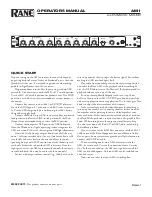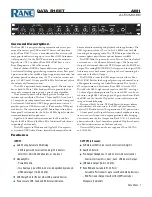
Stereo input
GAIN switch
Use the GAIN switch for switching between high (HI) or low (LO) input signal amplification.
The default setting is LO (-5 dB), which is suitable for all high level input sources like
keyboards or CD players. HI gain should be engaged when connecting low signal level
instruments like bass or guitar.
HI/MID/LO control
The mixer’s EQ section allows for a broad difference in the shaping of the incoming audio
signal within three frequency bands. Turning one of the EQ level controls to the right
enhances/amplifies the corresponding frequency range while turning it to the left lowers/
attenuates the signal of that specific frequency band. Before you begin to alter the sound, all
EQ controls should be set to their neutral position, i.e. their marker points straight up (locked
in place). Try not to set the EQ controls to extreme positions. Usually, minor changes are
sufficient to produce the best results in the overall sound. You should use the natural
reproduction as a starting point and rely on your musically trained ear. The moderate use of
the MID control is the best remedy to avoid acoustical feedback. You should try to avoid using
this frequency range to an extreme level. Lowering the level in this band will provide you with
higher output and help reduce feedback. Adjust the LO control to your taste, to add more
“punch” to the sound of a kick drum or “body” to the vocals. Use the HI control in the same
way to provide cymbals and vocals with more treble for a more transparent sound.
FX control
The FX controls is used to set the amount of effect you require on that channel input to be
routed to the integrated FX effects unit. The signal path is split post VOLUME control so that
the volume setting also influences the amount of the signal that is fed to the FX unit. Using the
FX controls lets you easily assign an effect for groups of musical instruments or vocals. To
determine the desired level of the effect, you should start with the controls set at their center
and make individual adjustments from there on.
Please monitor the PK LED in the FX channels. The indicator should only light up briefly at the
occurrence of high signal peaks. If the indicator is constantly lit, you should lower the send
levels of those channels where the program peaks occur. For further information, please read
the paragraphs about the FX unit.
AUX control
The AUX control is primarily meant for establishing an independent mix, e.g. for monitor or a
second room/zone. The signal routing is always pre VOLUME control.
PK indicator
The peak indicator plays a key role when setting input levels. The PK (peak) LED on the
PM 502 provides a visual indication of the risk of distortion before you hear it through the
connected speaker systems. The peak indicator checks the signal level pre and post of the
channel’s VOLUME control and indicates the maximum of both levels. If the PK LED blinks
frequently or lights continuously, the corresponding channel is likely to start clipping and you
will need to reduce the volume slightly. The peak LED are triggered at a level of -6 dB below
the point of distortion.
If lowering the channel VOLUME is not sufficient to reduce signal peaks, carefully turn the
GAIN control down.
Keeping an eye on the indicator during a performance is also a good idea, because some
changes in the bands dynamics or even a change in keyboard settings can easily lead to
channel clipping, resulting in the degradation of the overall sound.
7.2
22
en | Operation
PM 502
15-May-14 | 02 | F01U297804
User manual
Bosch Sicherheitssysteme GmbH
Содержание PM 502
Страница 1: ...PM 502 en User manual...
Страница 2: ......
Страница 37: ...Dimensions 9 1 PM 502 Technical data en 37 Bosch Sicherheitssysteme GmbH User manual 15 May 14 02 F01U297804...
Страница 44: ......
Страница 45: ......
Страница 46: ......
Страница 47: ......
















































